Hoosier Demographics: A Regional Perspective
Indiana has many regions, official and otherwise. The formal ones include the newly and federally defined metropolitan (and micropolitan) statistical areas; the Indiana Department of Commerce regions; the Indiana Department of Workforce regions; and others from various state and federal agencies. Informally, many people carve up the state into however they personally define north, central and south or northeast and northwest. For all of these needs, there is a special customizing feature on the web service STATS Indiana, allowing users to determine how they want to define a particular part of the state for a particular reason.
For this article, however, we are going to focus on the 12 relatively new Commerce regions (see Figure 1), which are now fully functional in terms of offices, and staff are beginning their work as catalysts to economic development in their regions.
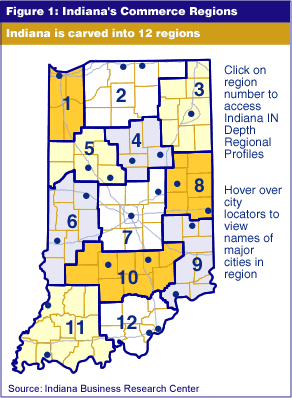
What is the current social and economic state of those regions? This article mines Census 2000 data to provide a view of the regions from a comparative perspective, relying heavily on the use of maps to provide us with the big picture, so to speak.
Population
More than 30 of Indiana's 92 counties experienced growth rates exceeding 40 percent between the beginning of the 1960s and the end of the 1990s (see Figure 2). While these high growth rates were scattered throughout the state, they were concentrated in central, southeast and northeast Indiana.
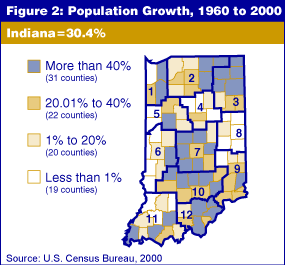
Not surprisingly, one of our oldest counties, Brown, in Region 10, is also one of our most rural (see Figure 3). But Region 10 also has one of the three youngest counties in the state, Monroe—home of Indiana University and its large student population. Lagrange County is young too, primarily due to the area’s large Amish population.
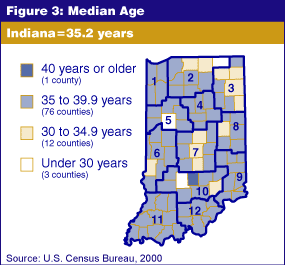
Education
At the time of Census 2000, the majority of adult Hoosiers (25 and older) had, at minimum, completed high school. Nearly 20 percent had a bachelor's degree or more, and a scant 5.3 percent of the population had not finished ninth grade. As would be expected, there are some significant regional differences in educational attainment. The variations can be seen in Figures 4 and 5.
Southern Indiana, particularly Region 11, has a high percentage of adults with an associate's degree (more than 7 percent). Northwest Indiana, as seen in Regions 1 and 2, has less than 6.1 percent with this level of college attainment (see Figure 4).
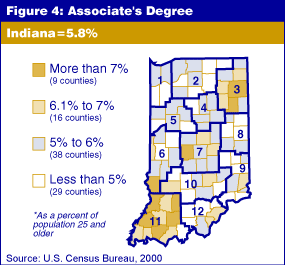
Region 7 has the largest percent of population with a bachelor's degree or higher. Figure 5 shows all of the regions with at least one county with a high percentage of adults with bachelor's or advanced degrees. However, eight of the 12 regions have at least one county where less than 10 percent of adults have attained a bachelor’s degree or more.
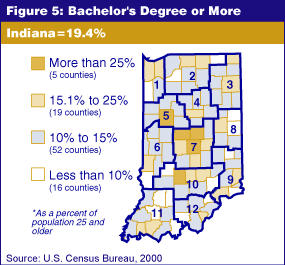
Income
Indiana's median household income in 2000 was $41,567, while median family income was pegged at $50,261. Household-based median income will always be lower than family income. Why? Because there are many households with just one person, thus just one income generator. Only two regions in Indiana, Commerce Regions 1 and 7, have counties with a median household income figure of more than $50,000 (see Figure 6). Just five regions have counties with medians between $45,001 and $50,000. The majority of counties fall into the brackets of $35,000 to $45,000.
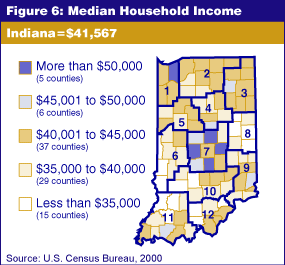
When there are families involved, and most likely multiple wage earners, we see a different picture for the regions (see Figure 7). Ten of the 12 regions have counties with median family incomes of $50,001 to $60,000. Only Regions 1 and 7 have counties with medians greater than $60,000. Not surprisingly, a substantial number of counties surrounding Indianapolis in central Indiana have median family incomes in excess of $60,000.
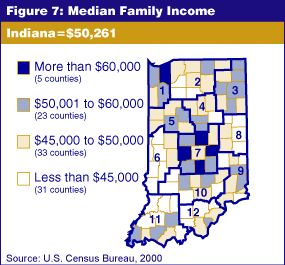
Eight Commerce regions have at least one county with over 12 percent of individuals in poverty (see Figure 8).
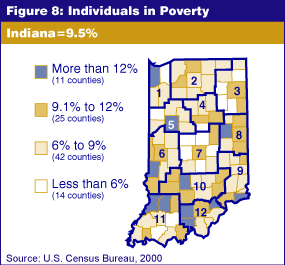
While families living below the poverty line (as defined by the federal government) can be found in all counties, the highest percentages are in mostly southern and rural Indiana (see Figure 9). In fact, looking at the family income map and the families in poverty map, one can clearly see the correlation.
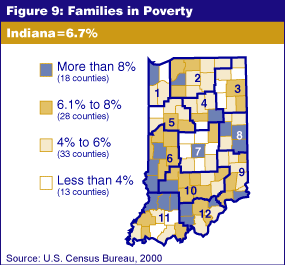
Housing
Indiana has one of the highest rates of homeownership in the nation, with nearly 72 percent of its housing occupied by households with or without a mortgage (see Figure 10). Indeed, 81 out of 92 counties have homeownership rates higher than the state as a whole. Those areas with lower rates of homeownership tend to be highly urban (Indianapolis, Gary, Fort Wayne and Evansville) or counties with high concentrations of college students and the resulting high proportion of rental housing (Delaware, Monroe and Tippecanoe).
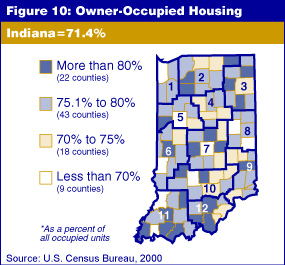
The median value of homes in Indiana is $94,300 (see Figure 11). There are a mere eight counties with median values (meaning an equal number above or below the stated median) higher than $115,000. The majority of counties have median home values between $70,000 and $100,000.
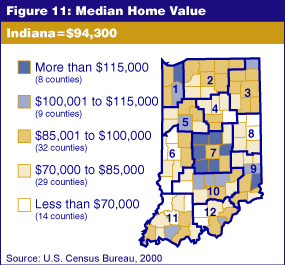
Lifestyles
Hoosiers tend to form family households, which, according to the Census Bureau, can be married couples, siblings living with a parent or two, single parents or just people living together who are related by marriage, birth or adoption. Nearly 70 percent of Indiana households are family households (where at least two people live who are related). Fifty-four percent of all Indiana households are married-couple families (see Figure 12), although fewer than half of those have children under the age of 18. Most single-parent households are mothers with children, although there has been a smaller but significant increase in the number of single-father households. Most non-family households (that is, no one in the household is related) are people living alone, a trend that is growing decade by decade across Indiana and the nation. One out of three home-alone households consists of someone over age 65.
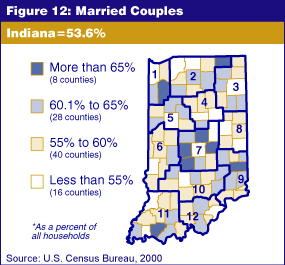
But there are regional differences. Figure 13 focuses on children in nuclear families (that is, living with both parents). Three of the 12 regions have counties where more than 85 percent of the children live with both parents (Regions 2, 7 and 11). All 12 regions have at least one county where fewer than 75 percent of children under 6 years of age live in a nuclear family situation. In Region 2, the majority of counties have situations where less than 75 percent of children under 6 live with both parents, whereas Region 7 has a much greater proportion of children living in such households.
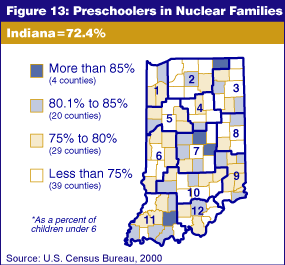
The trend toward living alone, which correlates with our aging population, is seen across all regions, since 29 of the 92 counties have home-alone rates close to or higher than the state average of 26 percent (see Figure 14). As one might expect, the regions with the lowest proportion of people living alone tend also to be those with higher proportions of married couples with children. Perhaps this is an indication that elderly parents are not necessarily living in the same county or region as their married children.
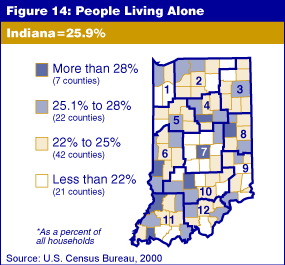
More than 56 percent of Hoosier children under 6 live in a household where both parents work, what we might call dual-income families (although the data do not necessarily indicate if there are others in the household working). Looking at Figure 15, it is not the most urban or metro counties that have the highest proportion of such families, but rather the suburban and rural counties in most of the regions. Regions 11 and 12 have the highest number of counties with children under 6 living in homes where both parents work.
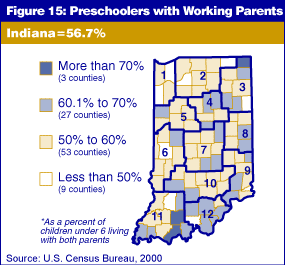
Carol O. Rogers
Associate Director, Indiana Business Research Center,
Kelley School of Business, Indiana University
